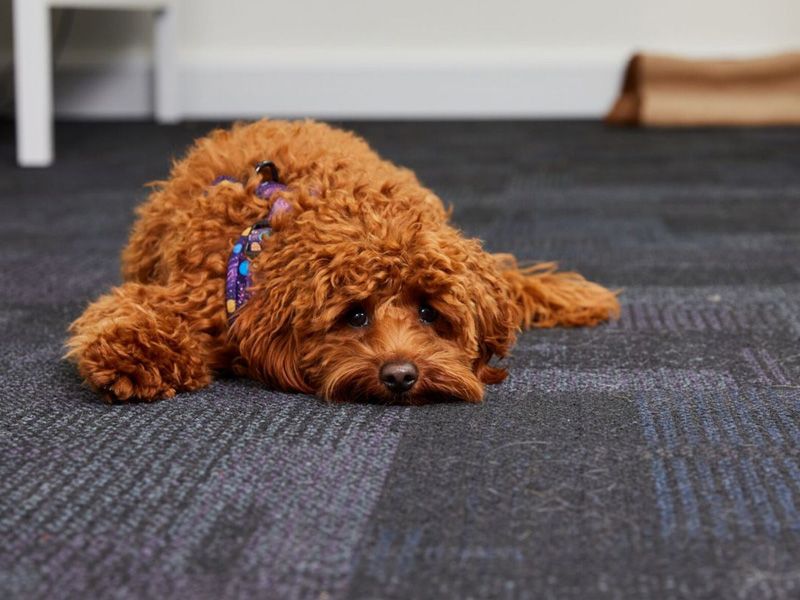What to do if your dog has separation anxiety
Find out how to help dogs that struggle when they are left home alone.

Our dogs like having us around. So when they eagerly follow us to the door, their expectant faces wondering where we are taking them, they could be disappointed to realise they are not always coming with us.
Dogs are social animals, and they need to learn that it is alright to be left at home on their own. But some may find this more difficult than others.
So, what exactly is separation anxiety and what do you do if your dog has it?
What is separation anxiety?
Some dogs feel anxious when they are left alone and may display unwanted and sometimes destructive behaviours as a result. Separation anxiety can develop in dogs for a number of reasons, but the most common is that they have never learned that it is ok to be alone.
Why do dogs get anxious when home alone?
Dogs are a naturally social species and it’s normal for them to stay close to their social group which is why they can become anxious when left alone. When a puppy is first separated from their mother and litter mates, their usual response will be to whine, whimper or bark while trying to get back to them.
To help prevent problems from developing, puppies need to learn to feel confident and relaxed when alone, in a very gradual and positive way.
How to find out if your dog has separation anxiety
If you think your dog may become anxious while you are out, start by finding out what they do when you’re not at home.
Set up a video camera in the space your dog spends most of their time so you can see what they get up to.
Some dogs with separation anxiety spend a lot of time at or near the door that you leave through, so you could set up a camera that covers this area.
You may need to try a few times before you find the best place to record what your dog gets up to. When you get it right, check the video for signs of anxiety.
What are the signs of anxiety in dogs?
If your dog is anxious, they may show some of these signs when left:
- whining
- barking/howling
- pacing
- trembling
- panting
- drooling
- destructive behaviour such as scratching and chewing at doorways or furniture
- urinating/defecating.
As most dogs show these types of behaviours when alone because they are worried, it’s important that you do not tell your dog off if you spot these signs when you get home.
Dogs do not know that these behaviours are ‘wrong’ and will not associate being told off when you come back through the door with something they did hours earlier, such as going to the toilet.
Instead, they may become worried about you coming home, as well as being anxious about being left.
What to do if your dog struggles with being left alone
If you identify signs that your dog may be worried, talk to your vet. It’s important to contact your vet first so they can check that there are no medical problems that may be influencing your dog’s behaviour. As separation problems can develop for different reasons, treatment programmes need to be tailored to individual dogs. Programmes usually include a number of different elements, which might include the following aspects:
- encouraging your dog to not be too reliant on your attention when you are at home, so that they can cope better when you are not there
- gradually teaching your dog that it is ok to be alone in the house through a process called ‘desensitisation and counter-conditioning’
- changing any associations your dog may have made about the events leading up to you leaving the house
- in some cases, making sure that your dog has had sufficient exercise and mental stimulation to help them settle down when left.
FAQs
If you think your pooch is showing signs of separation anxiety, then you no doubt have a lot of questions. Here are the most frequently asked questions, that will provide you with some of the answers you may be looking for.
When does separation anxiety start?
The signs of separation anxiety will often start in the first few minutes after the dog is left on their own. However, this is dependent on the individual dog and you will be able to tell more by using the camera to see how they behave once you leave the house and they are …
...How do I get my dog to stop crying when I leave the room?
No one wants to hear their dog crying when they leave the room or go to leave the house and there are ways to help them, but this should be specific to your individual dog. What works for one may not work for another and it will depend how severe their separation anxiety is.
...Is there medication for a dog with separation anxiety?
In most cases of separation anxiety, behaviour modification programmes alone are sufficient to resolve the problem. However, in some cases drug therapy can be useful in addition to behaviour therapy. The decision whether to include drug therapy in a treatment programme will be …
...If you have recently welcomed a four-legged friend into your home, then read our advice to help you get them used to spending time alone to help prevent separation anxiety from developing.


